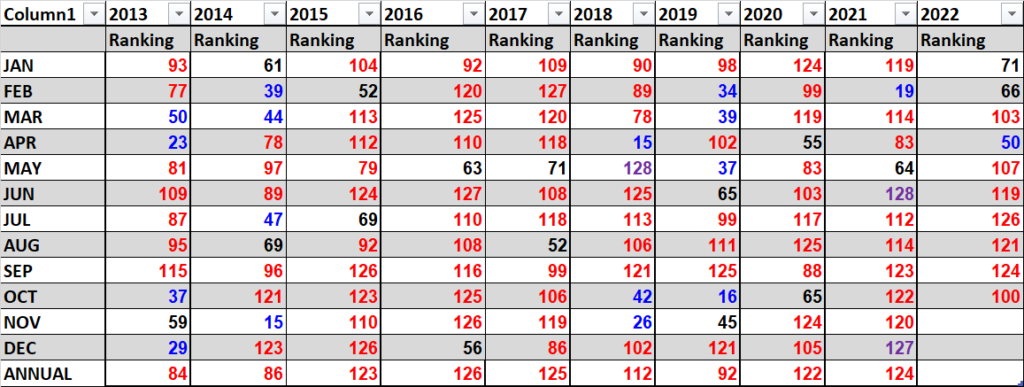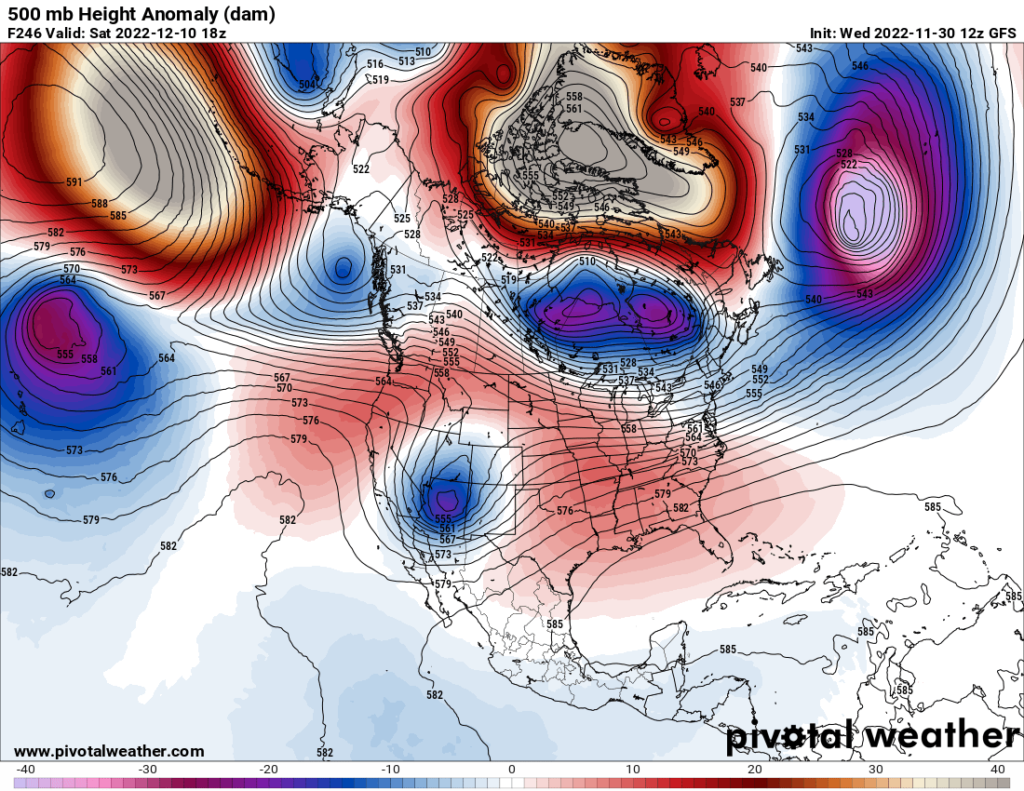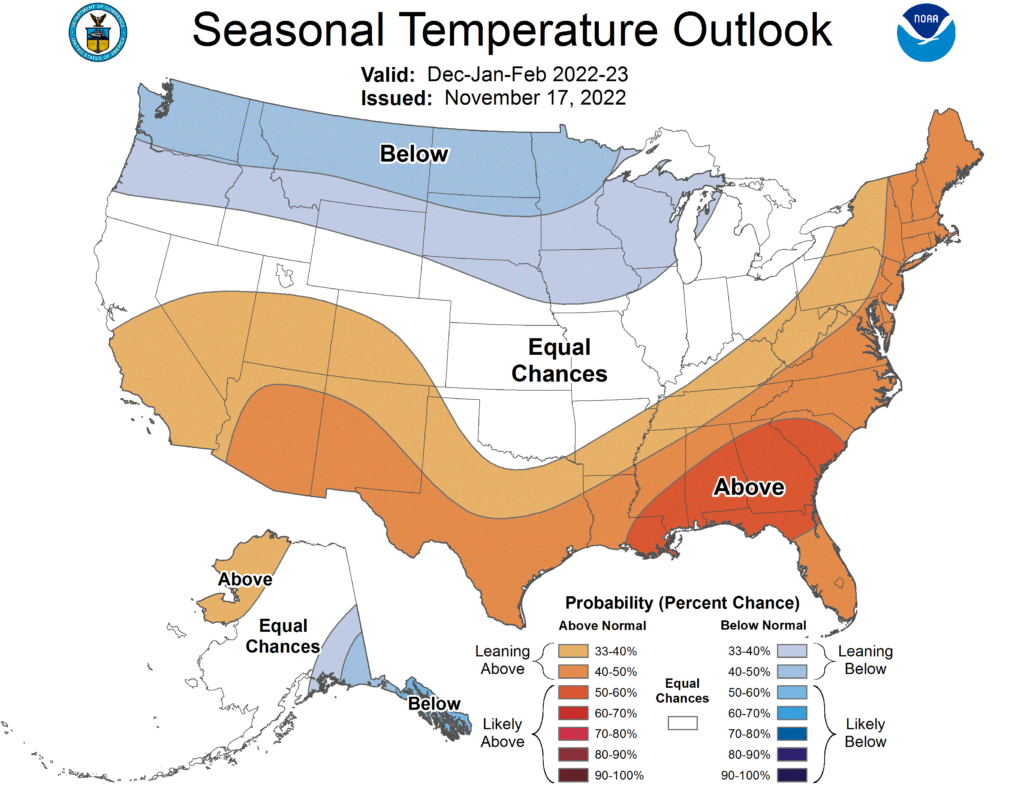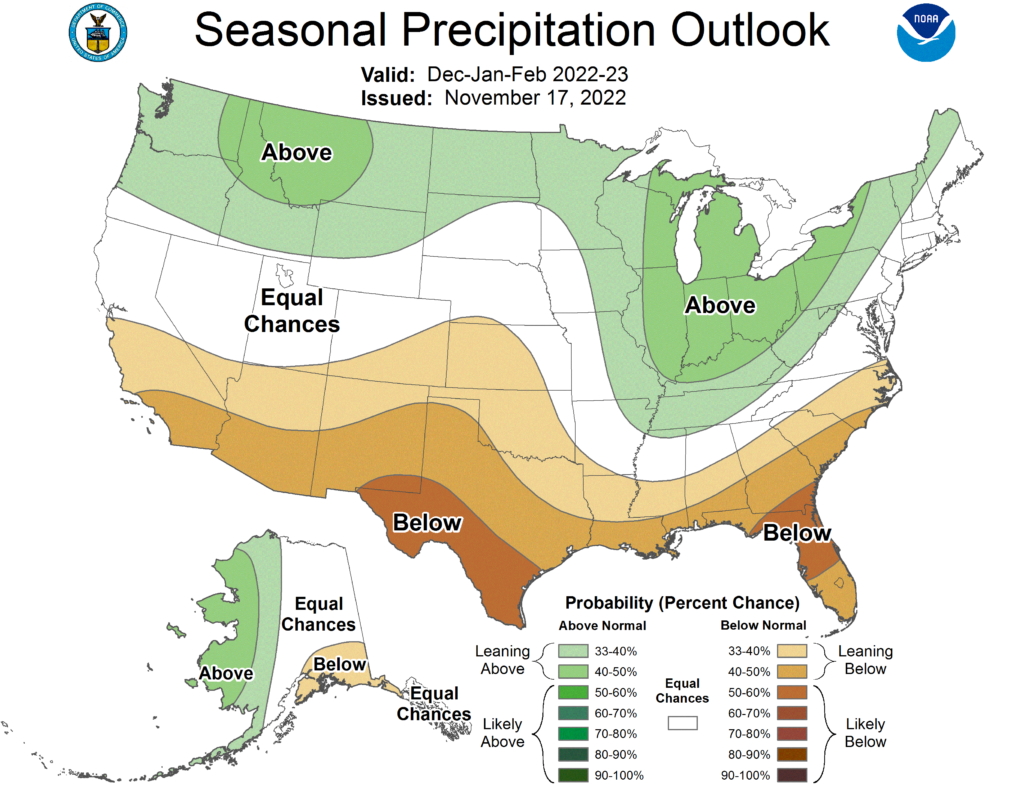The main purpose of this ongoing blog will be to track global extreme or record temperatures related to climate change. Any reports I see of ETs will be listed below the main topic of the day. I’ll refer to extreme or record temperatures as ETs (not extraterrestrials).😉
Main Topic: U.S. Average Temperature Winter Forecast
Dear Diary. Today is the last day of boreal or meteorological fall, so once again as we do on this blog, it is time to make a forecast for this coming winter. We have seen some anomalously very warm conditions across most of the United States for most of the summer and fall this year. Will that trend continue into winter?
At the very start of winter, it’s time for me to make another attempt at a forecast for average seasonal temperatures in the U.S. This forecast will be very broad and not specific for any one state comprising the continental United States (or lower 48 states).
So how did the forecast work out for Fall 2022? Here is a link to the post for that forecast:
By December 8th the National Center for Environmental Information will finish their assessment for Fall 2022, so our verification is not complete as of November 30th. Let’s do fill in ranking numbers with 1 being the coldest and 128 warmest for a verification for months during 2022, which have already been assessed:

Here are my two cents for a broad, rough forecast for the U.S. for Winter 2022/23, which I guarantee to be cooler than this past fall, of course, as the amount of daylight decreases across the Northern Hemisphere. First, I like to look at water temperature anomalies surrounding North America just before the start of a season to get a sense of how much potential anomalous heat can be added to the atmosphere across the continent. Here is what we see:

Water temperatures are above average across most of the U.S. coastal area. We also continue to see a healthy, cool La Niña across the equatorial Pacific, going into its third year of existence. These anomalies have not changed much since the beginning of the fall, except that we have seen some slight cooling along the West Coast. The way that these temperature anomalies have behaved during the fall leads me to believe that they will continue to have a positive effect on temperatures. A La Niña, however, can lead to colder than average conditions across the northern tier of states.
Second, I like to look at the strength and stability of the Hudson Bay low or polar vortex at the start of any season:

We don’t see a stable Hudson Bay low yet. In fact, this fall a weakened by climate change polar jet has been all over the place, with cold vortices forming over western Canada then moving across the continent. One dived southward through the Midwest, which produced our first significant cold outbreak during mid-November. I expect that this trend will hold true into December and January with some not too surprising cold outbreaks going through the middle of winter.
We will see some anomalously high 500 millibar heights over the South to start out December. Here is what we will find by December 3rd:

The spring like heat dome located over Texas and the Gulf Coast will oscillate back and forth from California through the Southeast well into winter keeping most of that area above average. In ten days, we should see this pattern:

Here we see what meteorologist call a southern branch of the jet storm system moving through the Southwest with a fairly weak looking vortex at least temporarily setting up camp in its climatological typical position over Hudson Bay. Anomalously high 500 millibar heights surround these two systems across the North American Continent. Therefore, we should see a fairly mild December during the first half of the first month of winter.
Here is the National Weather Service forecast for Winter 2022/23:


I can’t disagree much with their assessment for this winter, especially after noting what has been happening with coastal temperatures and trends going into December. Another big factor is the ongoing western drought, which unfortunately should raise temperature averages, especially in the West. Also, the NWS forecast reflects what we would see during a typical La Niña pattern.
Overall, Winter 2022/23 will probably verify above average looking at trends from the rest of the planet.
Last, we can get another clue looking at prior National Center for Environmental Information ranking and temperature record count data. For this I like to drag out that “Record Scoreboard” (updated through 11/27/2022):

DHMX= Daily High Max Reports. DLMN= Daily Low Min Reports. DHMN= Daily High Min Reports. DLMX=Daily Low Max Reports.
For these data sets all monthly ratios of > 10 to 1 DHMX to DLMN or > 10 to 1 DLMN to DHMX are in bold type. The rankings are for the lower 48 states with the warmest ranking since 1895 of average temperatures being 127 and 1 being the coldest as of 2021. Blue colors represent cold months and red warm. Those months and years with counts close to a 1 to 1 ratio of highs to lows are colored black. Boldly red-, blue-, or purple-colored months, such as January 2020 and June 2021, have ratios of >10 to 1 daily record highs to lows or <1 to 10 daily record highs to lows, and are either historically hot or cold, most of which have made news. New: All-time record hot or cold ranked months are highlighted in purple.
After a scorching summer, record numbers are trending down to “normal” one to one ratio levels during November. I would expect this new trend to hold at least through December.
I’m predicting that two out of the three winter months should be above average but not near record warm proportions. The most likely month for below average temperatures would be during December looking at record trends, but other factors indicate that this month will be above average. (Here is the link to avg. rankings per year for the lower 48 states since 1895):
https://www.ncdc.noaa.gov/cag/national/rankings
Not all seasons in the near future will see above average temperatures, but seasonal forecasters are beginning to ”chuck it,” discounting colder than average scenarios due to carbon pollution.
Again, here are all seasons ranked for the last decade:

An average ranking on the above chart would be 64 as of 2022.
Here is my bottom-line forecast for Winter 2022/23:
“I think that this winter will be ranked above average. Carbon pollution is definitely making below average seasons rarer. I’m going to forecast that the Winter 2022/23 ranking will be around 80 + or – 10, with near average confidence given all of the factors on this post.“
If my forecast verifies this will be the coldest winter since 2014. My hunch is that there will be one historic cold outbreak during the middle of the winter because of La Niña bringing averages down a bit.
My forecast for Summer 2022 of a ranking of 100 was 26 rankings too cool, and we will see how well my forecast ranking of 100 for Fall 2022 verified in a few days.
As of 2022 the top ranking for any month or season would be 128 since climatological rankings for the United States started in the year 1895. Carbon pollution is definitely making below average seasons rarer. As stated, I’m going to guess that Winter 2022/23 gets ranked around 80 + or – 10, and with near average confidence given all of the factors in this post.
We will see how this forecast pans out around March 7th, 2023.
Here are some “ET’s” recorded from around the planet the last couple of days, their consequences, and some extreme temperature outlooks:
Here is more climate and weather news from Wednesday:
(As usual, this will be a fluid post in which more information gets added during the day as it crosses my radar, crediting all who have put it on-line. Items will be archived on this site for posterity. In most instances click on the pictures of each tweet to see each article. The most noteworthy items will be listed first.)
If you like these posts and my work please contribute via the PayPal widget, which has recently been added to this site. Thanks in advance for any support.)
Guy Walton… “The Climate Guy”